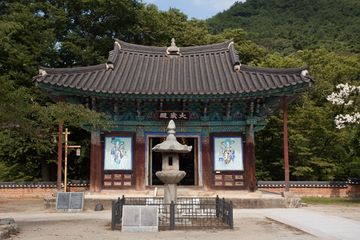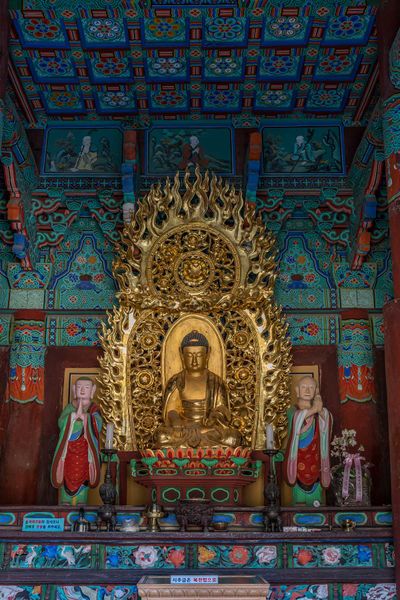김제 금산사 대장전
| 김제 금산사 대장전 Daejangjeon Hall of Geumsansa Temple, Gimje |
|
 김제 금산사 대장전, 국가문화유산포털, 문화재청. |
|
| 대표명칭 | 김제 금산사 대장전 |
|---|---|
| 영문명칭 | Daejangjeon Hall of Geumsansa Temple, Gimje |
| 한자 | 金堤 金山寺 大藏殿 |
| 주소 | 전라북도 김제시 금산면 모악15길 1 |
| 지정(등록) 종목 | 보물 제827호 |
| 지정(등록)일 | 1985년 1월 8일 |
| 분류 | 유적건조물/종교신앙/불교/불전 |
| 시대 | 조선시대 |
| 수량/면적 | 1동 |
| 웹사이트 | 김제 금산사 대장전, 국가문화유산포털, 문화재청. |
|
|
|
해설문
국문
대장경을 보관하기 위해 만든 목탑 양식의 전각이다. 정유재란 때 왜군의 방화로 소실되었으나, 인조 13년(1635)에 미륵전 앞에 다시 세워졌고, 1922년에 현재 위치로 옮겨 놓았다. 지붕 위에는 방등계단 오층석탑의 상륜부에 해당하는 복발과 보주 등이 설치되어 있다. 본래 금산사에서 간행된 불교 경전 등을 건물 내부에 보물처럼 보관하였지만, 경전 등이 유실되자 석가삼존상을 봉안하였다. 외부 벽체에는 ‘오달국사인명창’, ‘저지화상도담’ 등 10폭의 벽화가 그려져 있다.
영문
Daejangjeon Hall of Geumsansa Temple, Gimje
This building is a worship hall enshrining a Sakyamuni Buddha triad. Since it was first established in 766, the building has changed its function, design, and position, to the extent that it could be considered an entirely different structure. However, it has always been one of the major buildings of Geumsansa Temple and provides insight into the temple's history.
Originally, there was a wooden pagoda in front of Mireukjeon Hall dating back to 766 when the temple was expanded by Monk Jinpyo. A pagoda is a symbolic monument enshrining the relics or remains of the Buddha, but over time, this pagoda came to enshrine copies of the Korean Buddhist scriptures (Tripitaka Koreana) which had been published at the temple.
The pagoda was destroyed during the Japanese invasion of 1597. As the function of the building had already changed to being a repository for the Buddhist scriptures, it was decided that the building would be rebuilt in the shape of a typical worship hall rather than a pagoda. The building was completed in 1635 and was named Daejangjeon, meaning "Hall of the Tripitaka." It is unknown at what point the hall stopped enshrining the Buddhist scriptures, but in the 17th century, the current Buddha triad was enshrined here. Despite this change, the building kept its name. In 1922, the building was relocated slightly behind its original position, to allow for a better view of Mireukjeon Hall.
It is said that the stone decoration in the center of the roof ridge, which is not typically found on traditional roofs, is the remains of the decorative top of the original wooden pagoda. The outer walls of the building display mural paintings of Buddhist stories and the Buddhist paradise of the West. The Buddha triad inside the hall, which features an ornate golden halo behind the Buddha, is designated as Jeollabuk-do Tangible Cultural Heritage No. 253.
Short Version
This building is a worship hall enshrining a Sakyamuni Buddha triad.
When this worship hall was first built in 1635, it enshrined copies of the Korean Buddhist scriptures (Tripitaka Koreana), and was therefore named Daejangjeon, meaning "Hall of the Tripitaka." It is unknown at what point the hall stopped enshrining the Buddhist scriptures, but in the 17th century, the current Buddha triad was enshrined here. In 1922, the building was relocated slightly behind its original position, to allow for a better view of Mireukjeon Hall.
The outer walls of the building display mural paintings of Buddhist stories and the Buddhist paradise of the West. The Buddha triad inside the hall, which features an ornate golden mandorla behind the Buddha, is designated as Jeollabuk-do Tangible Cultural Heritage No. 253.
영문 해설 내용
이 건물은 석가모니불을 모신 전각이다. 766년에 처음 지어진 후, 기능과 형태, 위치 등이 크게 달라졌으나, 금산사의 주요 전각 중 하나로 사찰의 역사를 이해하는 데 중요한 자료가 된다.
원래 이 건물은 766년 진표율사가 사찰을 중창할 때 미륵전 앞에 목탑으로 지어졌다. 탑은 부처의 유골을 모시는 상징적인 조형물이지만, 시간이 흐르면서 사찰에서 간행된 불교 경전을 봉안하게 되었다.
목탑은 정유재란 때 소실되었다. 탑이 이미 경전을 보관하던 건물로 사용되고 있었기 때문에, 건물을 중건할 때에는 탑이 아닌 일반 전각의 형태로 짓게 되었다. 1635년에 건물이 지어졌으며, ‘대장경을 보관하는 전각’이라는 뜻으로 대장전이라 불리게 되었다. 그러나 언제부터인가 경전을 더이상 보관하지 않게 되었고, 17세기에 삼존불상을 모시게 되었다. 이러한 변화에도 불구하고 전각의 이름은 그대로 유지되었다. 1922년에 원래 위치에서 살짝 더 뒤로 옮겨져서 미륵전이 더 잘 보일 수 있도록 했다.
지붕 꼭대기에 남아있는 석조 장식은 일반적인 한국 전통 건축에서는 찾아보기 힘든 것으로, 원래 목탑의 상륜부였던 것으로 추정된다. 건물 외벽에는 불교 설화와 극락세계를 나타내는 벽화가 그려져 있다. 내부에는 황금빛 광배를 갖춘 석가모니불상(전라북도 유형문화재 제253호)이 모셔져 있다.
짧은 버전
이 건물은 석가모니불을 모신 전각이다.
1635년 건립 당시에는 이 건물에 경전을 보관하였기 때문에, 대장경을 보관하는 전각’이라는 뜻으로 대장전이라 불렀다. 그러나 언제부터인가 경전을 더이상 보관하지 않게 되었고, 17세기에 삼존불상을 모시게 되었다. 1922년에 원래 위치에서 살짝 더 뒤로 옮겨져서 미륵전이 더 잘 보일 수 있도록 했다.
건물 외벽에는 불교 설화와 극락세계를 나타내는 벽화가 그려져 있다. 내부에는 황금빛 광배를 갖춘 석가모니불상(전라북도 유형문화재 제253호)이 모셔져 있다.

